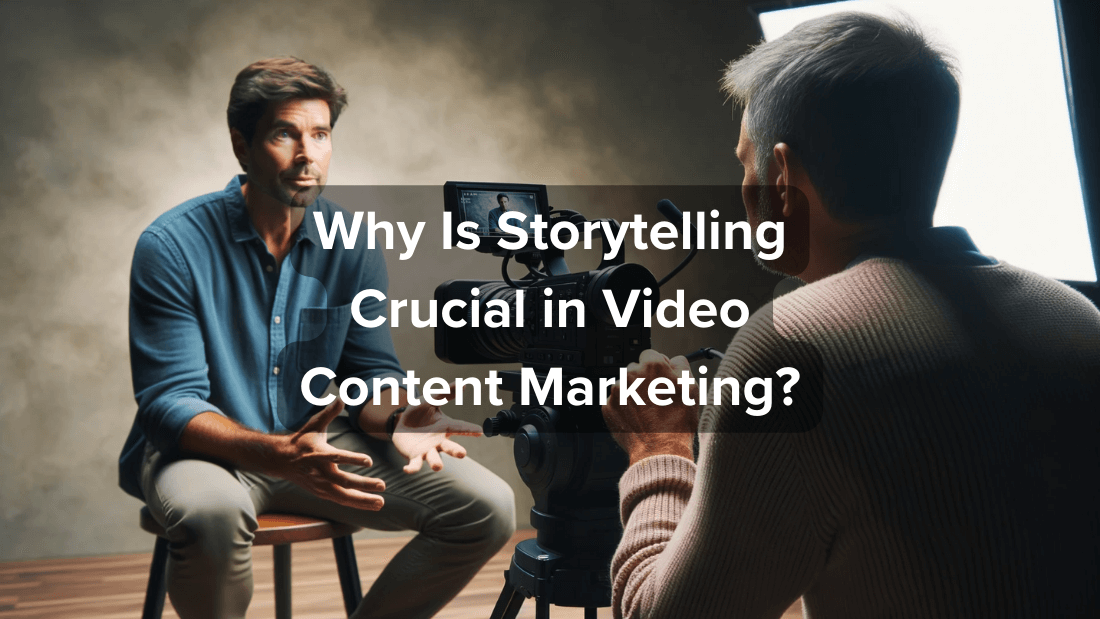In today’s digital landscape, capturing the attention of audiences has become increasingly challenging. However, there is a powerful tool that can cut through the noise and leave a lasting impact: storytelling.
By harnessing the art of narrative, video content marketers can create compelling, engaging, and authentic experiences that resonate with viewers on an emotional level.
In this article, we will explore why storytelling is crucial in video content marketing and how it can captivate audiences and drive success.
The Power of Storytelling
The power of storytelling lies in its ability to captivate and engage audiences, making it an invaluable tool in video content marketing. The art of storytelling has been a fundamental part of human communication for centuries, and its impact on marketing strategies cannot be overstated.
By using storytelling techniques in video content marketing, businesses can create a deeper connection with their target audience, evoke emotions, and leave a lasting impression.
Storytelling allows brands to convey their message in a way that is relatable and memorable. By presenting information in the form of a story, marketers can tap into the power of narratives to capture attention and make their content more engaging. When a story is well-crafted, it can transport viewers into a different world, sparking their imagination and making them feel a sense of connection with the brand.
Moreover, storytelling has the ability to evoke emotions, which is crucial in creating a lasting impact. By triggering emotions such as joy, sadness, or excitement, brands can make their audience more receptive to their message and increase the likelihood of them taking action. Emotionally charged stories have the power to leave a lasting impression, making viewers more likely to remember the brand and its message.
Incorporating storytelling into video content marketing allows businesses to differentiate themselves from competitors and stand out in a crowded market. By using narratives to convey their unique value proposition and brand story, companies can establish a strong emotional connection with their audience, fostering loyalty and trust.
Crafting a Compelling Narrative
To effectively craft a compelling narrative in video content marketing, it is essential to carefully structure and develop the storyline. This involves creating suspense and connecting with viewers on an emotional level. When crafting a narrative, it is important to have a clear understanding of the message you want to convey and the target audience you want to reach. By knowing your audience, you can tailor the storyline to resonate with their interests, needs, and desires.
One effective way to create suspense in your video content is by introducing a problem or conflict early on and gradually building tension throughout the narrative. This keeps viewers engaged and eager to see how the story unfolds. Additionally, connecting with viewers emotionally is crucial for making a lasting impact. By incorporating relatable characters and situations, you can evoke empathy and establish a connection with your audience.
Furthermore, it is important to structure the narrative in a way that captivates and holds the viewer’s attention. This can be achieved by using storytelling techniques such as a clear beginning, middle, and end, as well as incorporating elements of surprise and resolution. By carefully crafting your narrative, you can create a memorable and impactful video content that resonates with your audience and drives results for your marketing efforts.
Engaging Emotions Through Storytelling
How can storytelling in video content marketing effectively engage emotions? The answer lies in the power of emotional connection and visual storytelling.
Emotions play a crucial role in decision-making, and video content that evokes strong emotions has the potential to create a lasting impact on viewers. By tapping into the viewer’s emotions, storytelling can create a deeper connection between the brand and the audience. Whether it’s joy, sadness, anger, or surprise, emotions can elicit a response that goes beyond rational thinking and influences behavior.
Visual storytelling enhances the emotional impact by using compelling visuals, such as captivating imagery, animations, and cinematography techniques. When combined with a well-crafted narrative, these visuals can transport viewers into a different world, allowing them to experience the story on a more visceral level. This immersive experience helps to forge a stronger emotional bond with the brand and its message.
Moreover, emotional storytelling has the power to create memorable moments that stay with the audience long after they’ve watched the video. These moments can trigger word-of-mouth marketing and encourage viewers to share the content with others, amplifying the brand’s reach and impact.
Captivating Audiences With Authenticity
By showcasing authenticity, video content marketing can captivate audiences and further strengthen the emotional connection established through storytelling. Authenticity is crucial in building trust and creating connections with viewers. When audiences feel that a video is genuine and truthful, they are more likely to engage with the content and develop a sense of loyalty towards the brand or message being conveyed.
Here are three reasons why authenticity is essential in captivating audiences:
- Relatability: Authentic videos allow viewers to see themselves in the content. When they can relate to what they see, they are more likely to feel a personal connection and engage deeply with the message.
- Transparency: Authenticity in video content marketing means being transparent about the brand’s values, mission, and purpose. This transparency builds trust and credibility with the audience, leading to a stronger emotional connection.
- Real-life experiences: Authentic videos often showcase real-life experiences and stories. This approach helps viewers connect on a human level and creates a sense of authenticity that traditional advertising methods struggle to achieve.
Implementing Storytelling Techniques
Implementing storytelling techniques is essential for creating compelling and engaging video content in the realm of content marketing. A well-crafted story has the power to captivate audiences, evoke emotions, and leave a lasting impression. To effectively implement storytelling techniques, it is important to understand the storytelling structure and utilize visual storytelling.
The storytelling structure consists of three main components: the setup, the conflict, and the resolution. The setup introduces the characters, setting, and context of the story, setting the stage for what’s to come. The conflict creates tension and keeps the audience engaged, as they anticipate how the story will unfold. Finally, the resolution brings closure and provides a satisfying conclusion.
Visual storytelling plays a crucial role in conveying the story. It involves using visuals such as images, videos, and animations to enhance the narrative and create a visually appealing experience. By incorporating visual elements that align with the story, marketers can effectively communicate their brand message and connect with their audience on a deeper level.
Implementing storytelling techniques in video content marketing allows brands to stand out from the competition and create a lasting impact. By crafting a compelling story, utilizing the storytelling structure, and leveraging visual storytelling, marketers can create videos that engage, inform, and persuade their target audience.
Frequently Asked Questions
What Are Some Practical Tips for Incorporating Storytelling Into Video Content Marketing?
Incorporating storytelling in video content marketing can greatly enhance its effectiveness. By following practical tips such as creating relatable narratives, incorporating emotions, and using visual storytelling techniques, marketers can create engaging and persuasive video campaigns. Measuring the impact of storytelling is crucial for optimizing future content.
Can You Provide Examples of Successful Video Content Marketing Campaigns That Effectively Use Storytelling?
Successful video content marketing campaigns effectively use emotional storytelling to evoke strong emotions in viewers. They also utilize brand storytelling to establish the brand’s identity and connect with the target audience, resulting in a powerful and engaging video marketing strategy.
How Does Storytelling in Video Content Marketing Help to Establish a Brand’s Identity and Connect With Its Target Audience?
Storytelling in video content marketing plays a crucial role in establishing a brand’s identity and connecting with its target audience. By weaving narratives that evoke emotions, brands can create a compelling and memorable experience, fostering a deeper connection with their audience.
Are There Any Specific Storytelling Techniques That Work Better Than Others in the Context of Video Content Marketing?
Different storytelling techniques in video content marketing can have varying impacts on brand identity and audience connection. By utilizing specific techniques such as narrative structure, emotional storytelling, and visual storytelling, marketers can effectively engage and connect with their target audience.
How Can Video Content Marketers Measure the Effectiveness of Storytelling in Their Campaigns?
Measuring the impact and analyzing the engagement of storytelling in video content marketing campaigns is crucial for video content marketers. By evaluating key metrics such as views, click-through rates, and audience retention, marketers can gauge the effectiveness of their storytelling techniques.
Conclusion
In conclusion, storytelling plays a crucial role in video content marketing by harnessing the power of narratives to captivate and engage audiences. By crafting a compelling narrative and engaging emotions, brands can create a genuine connection with their viewers.
Authenticity is key in implementing storytelling techniques that resonate with audiences and drive results. According to a study by HubSpot, videos that incorporate storytelling receive 2.5 times more clicks and shares compared to traditional marketing videos.





